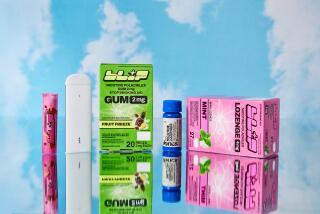Kava ‘anti-energy’ drink takes root in the Southland
- Share via
In Los Angeles, where medical marijuana dispensaries outnumber Starbucks and McDonald’s restaurants combined, a mood-altering beverage with a cannabis-oriented marketing campaign is gaining traction.
Southern California has become the bestselling market for Mary Jane’s Relaxing Soda, a sugary drink laced with kava, a South Pacific root purported to have sedative properties.
Matt Moody, a Denver nutritional supplement developer who created the beverage, said the name is an unabashed reference to weed, though the relaxant compounds in kava are chemically unrelated to those in marijuana.
Along with drinks like Slow Cow and Ex Chill, Mary Jane’s is part of a new group of so-called slow-down or anti-energy drinks, which are expected to be among the top food trends of 2010, according to advertising agency J. Walter Thompson.
They rely on folk-medicine sedatives, including kava, camomile and valerian, to provide an alternative to caffeine-laced and jitter-inducing energy drinks such as Red Bull.
The drinks purportedly promote calming, and they also take on the energy-drink category directly by claiming also to boost mental focus and concentration, said Ann Mack, director of trend-spotting at the ad agency.
Said Travis Arnesen, spokesman for Ex Drinks of Henderson, Nev.: “It is a new category, kind of like energy drinks, but designed to relax people. Just recently it has been picking up steam.”
The company’s Ex Chill drink comes in an 8.4-ounce can that sells for $2 at Albertsons, 7-Elevens and some Bristol Farms markets. Slow Cow, made by Boisson Slow Cow Inc. of Quebec, Canada, plans to start distribution in the U.S. next year.
These “relaxation” drinks have become popular fodder for food bloggers, with some calling Mary Jane’s “weed in a bottle.”
Kava has long been “a popular recreational drug through much of the Pacific, especially Vanuatu, Fiji, Samoa and Tonga,” said Lamont Lindstrom, a University of Tulsa anthropologist who has studied the use of the plant in Pacific Islander culture.
The calming effect is probably real, said Michael Pollastri, a pharmaceuticals chemist at Boston University.
“If there were not therapeutic effects, it would not be a 1,000-year-old folk medicine,” Pollastri said.
Kava warrants a closer look by drug chemists to figure out how it works as a relaxant and what else it might be useful for, but that work is just beginning, Pollastri said.
There are no age limits or restrictions for consumers. Medical experts, however, caution that drinks containing kava and other supplements could have a downside, depending on the chemical compounds used as ingredients and how the plants are processed.
The Food and Drug Administration has issued a consumer warning that people with “liver disease or liver problems, or persons who are taking drug products that can affect the liver, should consult a physician before using kava-containing supplements.” But the agency has not restricted sales of kava-based products.
The warning hasn’t dissuaded Kristie Richardson, a new mother from San Clemente, from using Mary Jane’s to unwind after a difficult day of work at a medical systems company.
On the way home, Richardson frequently drops into a local 7-Eleven to pick up several bottles, which sell for $2.49 each.
“I put my 7-month-old to bed, open up a Mary Jane’s Soda and chill,” Richardson said.
She described the drink as “sweet tea meets cola,” and said “it helps me to unwind” and makes a good alternative to alcoholic beverages, which Richardson said she doesn’t drink.
Moody developed the beverage after he was laid off a year ago from a nutritional supplement company. “I had experience with kava in the past,” he said. “I knew it was effective but not widely used in the U.S.”
The kava root’s “awful taste” was one reason it has not gained the same acceptance as other folk-based nutritional supplements, Moody said.
But blending it into a drink that contains cane sugar solved that. Another beverage company makes it on contract for his Moody’s Denver-based Mary Jane’s Soda Inc.
About 70% of the company’s retail sales are in Southern California, Moody said. The drink’s market is so concentrated in the region that Moody plans to move the business to the Inland Empire.
The 7-Eleven stores stocking Mary Jane’s sell the product at a rate of about 14 bottles a day, which is considered a healthy pace for a niche beverage, Moody said. It also sells in scattered bars and cafes and online through the Mary Jane’s Soda website.
Nathan Scholl, a waiter at a Santa Monica restaurant, said he was “hooked” on the cola-colored liquid, which comes packed in a clear 12-ounce bottle with a blue label.
Though the drink doesn’t make him high, Scholl said, he finds “the whole Mary Jane thing funny.”
“I drink it after a long day. It takes five or 10 minutes to sink in and then I feel relaxed and slightly euphoric,” he said.
twitter.com/latimesjerry
More to Read
Eat your way across L.A.
Get our weekly Tasting Notes newsletter for reviews, news and more.
You may occasionally receive promotional content from the Los Angeles Times.











